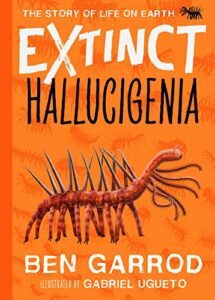 I distinctly recall the first time I saw an photographic image of a Hallucigenia fossil; I couldn’t sufficiently make heads or tails of it – a mental conundrum I no doubt shared with many paleontologists when they first took up the study of it as well. Seeing subsequent images of it as reconstructed to how it would have (probably…) appeared while alive didn’t greatly improve this. However despite not being able to imagine with any clarity just what this creature was, I was captivated by the fact that it did, 450 million years ago, once, in all of its remarkable as well as perplexing bodily form, exist – in sufficient numbers in fact to have allowed us to find fossils of it to confuse us. Well, at least the adults among us, that is; children have much more vivid imaginations.
I distinctly recall the first time I saw an photographic image of a Hallucigenia fossil; I couldn’t sufficiently make heads or tails of it – a mental conundrum I no doubt shared with many paleontologists when they first took up the study of it as well. Seeing subsequent images of it as reconstructed to how it would have (probably…) appeared while alive didn’t greatly improve this. However despite not being able to imagine with any clarity just what this creature was, I was captivated by the fact that it did, 450 million years ago, once, in all of its remarkable as well as perplexing bodily form, exist – in sufficient numbers in fact to have allowed us to find fossils of it to confuse us. Well, at least the adults among us, that is; children have much more vivid imaginations.
And it is to children that Prof. Ben Garrod addresses the volumes of his new Extinct series of books from the independent London-based publisher Head of Zeus Books, the inaugural volume of which takes the story of Hallucigenia as its subject. With vivid and compelling illustrations provided by Gabriel Ugueto, Prof. Garrod leads his readers – with the enthusiasm about his subjects for which he has become so well known and respected – through what is presently known about this very curious Ordovician creature (creatures, in fact, as fossils of what are thought to be three different species have thus far been discovered), teaching them along the way the necessary biological concepts needed to understand how it lived and why it is no longer found among living creatures today.
As a copy of this book has just reached me, I have thus far only given it a quick thumb-through, however even from that I can clearly see that Prof. Garrod and Mr. Ugueto have combined the right balance of visuals with informative text to both inspire imagination and feed the curiosity of their primary audience. Furthermore, as this is the inaugural volume of what is planned as a series detailing the natural histories and extinctions of a range of creatures, including Trilobites, Dunkleosteus, and other favorites from the distant past up to our own time, my hopes and expectations are high both for the quality and future success of these very much needed books.
Available from:
If you enjoyed reading this, please consider signing up for The Well-read Naturalist's newsletter. You'll receive a helpful list of recently published reviews, short essays, and notes about books in your e-mail inbox once each fortnight.

